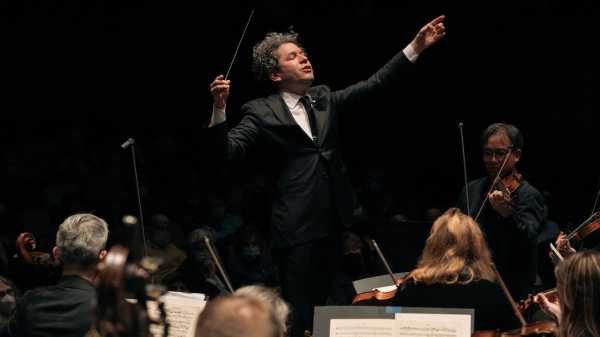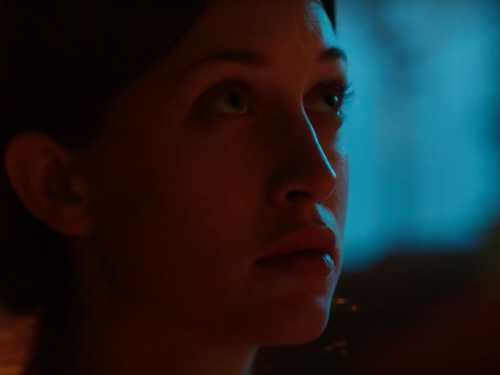
No one wants to hear anything more about the purported rivalry between New York and Los Angeles—two self-fascinated metropolitan regions vying for control of the national psyche, to the irritation of the remainder of the country. Nonetheless, the dread topic resurfaced last week, when it was announced that Gustavo Dudamel, the current music director of the Los Angeles Philharmonic, would, in a few years’ time, go east to take the same job at the New York Philharmonic. The appointment was variously described as a “coup,” a “major coup,” a “total coup,” and an “East Coast coup.” Los Angeles was thought to be reeling from the blow. It was, according to a New York Times report from L.A., “a strike at the soul of this city.”
To the extent that the broader population of Angelenos was distraught at the news—they were probably focussed more on LeBron James’s 38,388th point—they can take solace in the fact that the notional coup exemplifies what a recent Times article characterized as the Los Angelizing of New York, supposedly evident in such trends as mocktails, sound baths, early dining, and ketamine. Likewise, the N.Y. Phil has a habit of imitating the L.A. Phil, which, since the Esa-Pekka Salonen era of the nineties and two-thousands, has been the trendsetting heavyweight among American orchestras. Alan Gilbert, who led the N.Y. Phil from 2009 to 2017, initiated a new-music series along the lines of L.A.’s Green Umbrella concerts. After Gilbert’s departure, the N.Y. Phil considered approaching Salonen before settling, to widespread bafflement, on Jaap van Zweden, the Millard Fillmore of music directors. It then brought in Deborah Borda, the longtime chief executive of the L.A. Phil. Borda oversaw a renovation of Geffen Hall that borrows motifs, with mixed success, from Frank Gehry’s design for Disney Hall, the L.A. Phil’s home. With the advent of Dudamel, the putative L.A.-ification of New York is complete.
The L.A. audience has cause to lament, up to a point. Dudamel, who began his tenure in 2009, is, without question, a remarkable talent, one whose loss will be widely felt. He is that rarest of creatures, the crossover classical-music celebrity, his curly coiffure and amiable manner recognizable from appearances on “60 Minutes” and the like. More important, he is a hugely gifted musician who establishes authority without aggression. He has assisted in the hiring of around forty L.A. Phil players, fostering a uniformly excellent ensemble. An alumnus of El Sistema, the storied, troubled youth-orchestra system in Venezuela, he has thrown himself into educational efforts, inspiring the creation of the Youth Orchestra Los Angeles (YOLA). He delights in outdoor-conducting duties at the Hollywood Bowl. His prominence as a Latino cultural leader stirs intense local pride.
In recent years, though, Dudamel’s relationship with the L.A. Phil seems to have cooled somewhat, or, at least, levelled off. This was inevitable: any orchestra-conductor pairing undergoes gradual decay. When Dudamel departs, in 2026, he will have been in L.A. for seventeen years, as long as Salonen was there before him. (Salonen is now at the San Francisco Symphony.) Dudamel arrived as a brilliant young man of twenty-eight, thrilling audiences merely by walking onstage. Now entering middle age, he delivers solid, assured performances that don’t always linger in the memory. Textures are rich, melodic gestures broadly drawn, climaxes punchy; yet the over-all effect can be oddly diffuse. Last week, he led the L.A. Phil in Rachmaninoff’s “Symphonic Dances,” and it was a typical outing. Dudamel marshalled the music along without sparking much tension or delving too deep into the score’s darker corners.
His limitations were apparent from the start. I wrote, in 2009, “Although Dudamel has the image of an impulsive conductor, a wild man of lunging arms and dancing feet, his musical choices tend to be controlled, sometimes a little predictable.” The assumption had been that his interpretations would mature and deepen as he got older, but his approach hasn’t changed markedly in the past decade and a half. He was, in a way, too mature from the start. In 2012, my colleague Justin Davidson, of New York, called him “the world’s only old-fashioned young conducting superstar.” Still, on his best days, he obtains magnificent results. I won’t soon forget his darkly propulsive account of Dvořák’s Seventh Symphony, in early 2020, at Disney Hall, or his rugged reading of Beethoven’s “Eroica,” at the Bowl, the following year.
Perhaps Dudamel will realize his full potential at the New York Philharmonic. He has established a good rapport with the orchestra, going back to his accomplished début there, in 2007. Perhaps, too, he can pull a famously quarrelsome bunch out of decades of grumpy nostalgia. Unlike its future-oriented counterpart on the West Coast, the New York Philharmonic is always looking back to its glory days under Mahler, Toscanini, Bernstein, and Boulez. It’s worth noting that many conductors have left the post frustrated, exhausted, or embittered. Boulez came back rarely. Bernstein gravitated toward the Viennese. Toscanini pondered retirement. Mahler died. In place of the endless pining after lost glamour, the orchestra would be better off asking how it should define itself in relation to the city’s culture and to the world at large. Alan Gilbert was the one music director in recent decades who posed those bigger questions.
We won’t know for several years how much Dudamel will commit himself to New York. His home is in Spain, and he holds a demanding position at the Paris Opera. He is absent from Los Angeles for months at a time. Celebrity conductors who profess to inhabit several cities at once are a dubious fixture of modern musical life. On the last day of January, Dudamel joined two West Coast colleagues, Salonen and Rafael Payare, in announcing the California Festival, a statewide series that will take place next fall. On video, he was seen extolling the uniqueness of California’s identity. Just seven days later, discussing his next destination, he extolled the unlimited possibilities of New York. The show is moving on.
Although it will be difficult to find another conductor who can match Dudamel’s box-office appeal, the L.A. Phil ultimately has no need for a stereotypical maestro-genius figure who animates the usual fare. Salonen’s singular achievement—for which he had considerable assistance from the visionary administrator Ernest Fleischmann—was to have dismantled that model, making modern music and living composers central to the orchestra’s identity. If Dudamel represented something of a backward step, he has, much to his credit, proved a deft, selfless interpreter of dozens of new works, including John Adams’s “The Gospel According to the Other Mary,” Andrew Norman’s “Play,” and Thomas Adès’s “Dante.” He has also been a keen partner in nontraditional events, such as a production of “Fidelio” with the Deaf West Theatre and a video-enhanced adaptation of Prokofiev’s “Romeo and Juliet” with Benjamin Millepied and the L.A. Dance Project.
The person best poised to carry on the L.A. Phil’s mission is Susanna Mälkki, who was the orchestra’s principal guest conductor from 2017 to 2022. Now fifty-three, she comes from the same inexhaustible Finnish talent pool that yielded Salonen, and, like him, she first won notice as an advocate for new music. Two summers ago, she presided over one of the great operatic events of the century so far—the première of Kaija Saariaho’s “Innocence,” in Aix-en-Provence. Mälkki has shown equal assurance in mainstream repertory at the L.A. Phil, delivering boldly colored, finely etched performances of Berlioz’s “Symphonie Fantastique,” Mahler’s Fifth Symphony, and Strauss’s “Alpine Symphony.” In 2021, she led an account of Rachmaninoff’s “Symphonic Dances” that outdid Dudamel’s in tonal variety and narrative drive. She brought out the score’s modernist touches, accentuating the macabre atmosphere of the middle movement, but she also coaxed the strings into a mightily unified singing line. She is, to be sure, no household name, as Dudamel already was in his twenties; but a woman taking charge of a world-renowned orchestra would be a news story of note. So far, this has happened only in the movies.
In the weeks before Dudamel’s announcement, the L.A. Phil demonstrated how much interest it can generate even when its music director is occupied elsewhere. A Green Umbrella concert offered three premières, including Erika Vega’s “No Oyes Ladrar a los Perros” (“Don’t You Hear Dogs Barking?”), for organ and ensemble—a variously rumbling and glittering response to a story by the Mexican author Juan Rulfo. The composer-conductor Matthias Pintscher turned a spotlight on the Austrian avant-gardist Olga Neuwirth, programming her orchestral piece “Masaot/Clocks Without Hands” and also presenting, with the Ensemble Intercontemporain, Neuwirth’s smoldering score for the unsettling Austrian silent film “Die Stadt Ohne Juden” (“The City Without Jews”). John Adams was on hand to conduct concert performances of a revised version of his opera “Girls of the Golden West,” with a shortened second act that hurtled toward disaster and epiphany. Roderick Cox delivered a bracing rendition of William Dawson’s “Negro Folk Symphony,” a neglected American classic from 1934. Amid such novel fare, we had a celebrated older conductor leading a standard-repertory piece, in the form of Michael Tilson Thomas meditating on Mahler’s Ninth; yet this awe-inspiring occasion revealed not just Tilson Thomas’s resilience in the face of illness but also the musicians’ heroic focus as they sustained lines at daringly slow tempos.
The phenomenon of the superstar maestro is a product of the international culture industry of the early twentieth century. As Theodor W. Adorno observed, conducting is at once a necessary musical undertaking and a form of charlatanism—an “imago of power,” acted out for the audience’s benefit. At intervals, commentators have predicted the demise of the maestro cult; I’ve made the suggestion myself, with more hope than conviction. The immense fuss over Dudamel shows that the cult is alive and well, yet the conductor’s integration into the variegated organism of the L.A. Phil indicates that a different model is possible. The orchestra itself, with its tradition of reinvention, is a greater star than anyone who shows up on the podium. This is true in most places, but in Los Angeles the reality is closer to the surface. ♦
Sourse: newyorker.com






